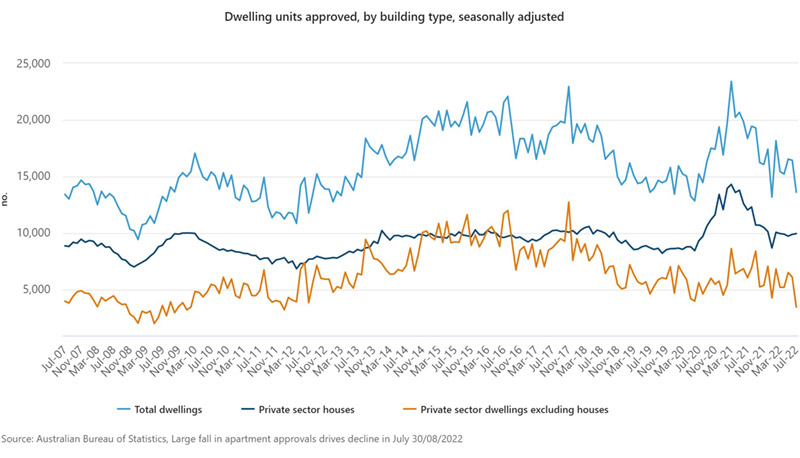Building approvals fall sharply as inflation, interest rates bite
A lack of approvals for large apartment developments has hit the building industry hard, with the total number of dwelling approvals falling a whopping 17 per cent in July.
Building approvals fell sharply in July, with the latest figures showing they tumbled 17.2 per cent as rising inflation, interest rates and labour shortages took their toll on the industry.
While house approvals actually rose slightly, up 0.7 per cent in July according to the Australian Bureau of Statistics, the large decline was led by a lack of approvals for apartments.
Daniel Rossi, head of construction statistics at the ABS, said the decrease in the total number of dwellings approved in July was led by a sharp decline in approvals for private sector dwellings excluding houses, which dropped by 43.5 per cent.
“Approvals were at the lowest level recorded since January 2012 and was driven by a lack of approvals for large apartment developments,” he said.
“Approvals for private sector houses remained steady, rising 0.7 per cent in June, following a 1.6 per cent increase in June.”
Call for action
In response to the data released Tuesday (30 August), the Urban Development Institute of Australia (UDIA) called for urgent action to reverse “this concerning trend”.
Among the measures it suggested was reducing the regulatory burden, implementing cost reducing measures, and reintroducing incentives for off-the-plan buyers and investors to help underpin the viability of new projects.
National President of the UDIA, Maxwell Shifman, said the concern was that this fall in approvals disproportionately impacts the more affordable end of the market, with reduced supply for those seeking to buy smaller dwellings such as townhouses or apartments, particularly near activity centres.
“Unless these issues are addressed with great urgency, we will see a continued push away from densification in our cities, and even more pressure on greenfield development,” added Mr Shifman.
“At a time when we need to be planning for population growth after a two-year hiatus, the last thing Australians can afford is a reduction in new home supply.”
He said the precipitous decline reflects the many challenges affecting the attached housing market, including continuous increases in red tape, planning regulations, rapidly escalating construction costs, and the removal of investment incentives (such as off-the plan stamp duty concessions and increased foreign investor surcharges).
“This has been exacerbated with the general negative concerns that have been growing against apartment living.”
The challenges to the building industry come as a seven-star energy efficiency rating and minimum accessibility standards will be enforced in all new homes built from October 2023.
Housing Industry Association Economist, Tom Devitt, said the strong volume of house approvals in recent months reflects the significant volume of new homes across Australia that had been sold earlier in the year, but not yet approved.
“The strong volume of approvals in July 2022 hides the impact that rising interest rates are already having on more timely data.
“Given the large volume of work under construction and approved but not commenced, there will be a significant lag between the increase in the cash rate and an adverse impact on new home construction.
“The long lead times in this current cycle will hide the impact of rate rises and risk the RBA over shooting with unnecessary rate increases,” Mr Devitt concluded.
National variations
While the headline figure of a 17.2 per cent overall fall in building approvals is alarming, the variation between states and building types was significant.
South Australia was the only state to avoid the enormous downswing.
Western Australia had the largest drop in the number of dwelling approvals (-36.9 per cent), followed by Victoria (-17.4 per cent), New South Wales (-16.2 per cent), Tasmania (-14.5 per cent) and Queensland (-13.7 per cent). Dwelling approvals rose in South Australia 19.2 per cent, in seasonally adjusted terms.
House approvals were actually up in all but two states.
Approvals for private sector houses rose in South Australia (18.6 per cent), Queensland (5.8 per cent) and Victoria (1.5 per cent). Declines were recorded in Western Australia (-8.7 per cent) and New South Wales (-6.3 per cent), in seasonally adjusted terms.

National unit prices are also falling, now 0.2 per cent lower over the year to date.
The fall in approvals translated into a corresponding fall in value of building approved.
The seasonally adjusted estimate for the value of total building approved fell 12.9 in July, following a 6.2 per cent fall in June. The value of total residential building fell 6.1 per cent, comprising of a 6.9 per cent decline in new residential building, and a 1.3 per cent decrease in alterations and additions.
The seasonally adjusted estimate for the value of non-residential building fell 22.6 per cent, driven by falls in both private and public sector approvals in July.
In more ABS data released Wednesday (31 August), in seasonally adjusted terms in the June quarter:
- total construction work done fell 3.8 per cent to $52,073.6m
- building work done fell 4.6 per cent to $29,587.1m
- engineering work done fell 2.7 per cent to $22,486.5m
Loan commitments fall
The value of new loan commitments for housing fell 8.5 per cent to $28.4 billion in July 2022 (seasonally adjusted) after a fall of 4.4 per cent in June, according to data released Thursday (1 September) from the Australian Bureau of Statistics (ABS).
Katherine Keenan, ABS head of Finance and Wealth, said the value of new owner-occupier loan commitments fell 7.0 per cent in July 2022, while new investor loan commitments fell 11.2 per cent.
“Although lending has fallen from historically high levels recently, the value of loan commitments remained significantly higher than pre-pandemic levels.
“Owner occupier loans in July 2022 were 40 per cent higher than February 2020, while investor loans were 78 per cent higher.”




















